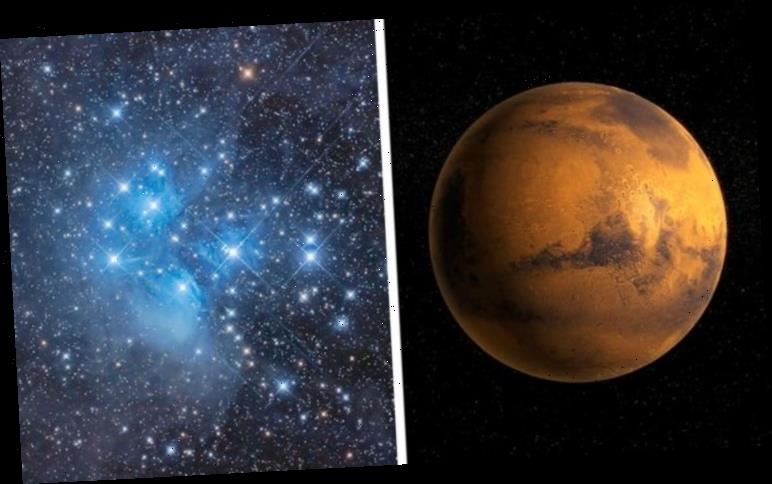Perseverance Rover shares its first audio recording from Mars
When you subscribe we will use the information you provide to send you these newsletters.Sometimes they’ll include recommendations for other related newsletters or services we offer.Our Privacy Notice explains more about how we use your data, and your rights.You can unsubscribe at any time.
The Red Planet is charting a path across the western skies this week where it will soon meet the Pleiades cluster. No matter where you live, Mars should be readily visible in the west in the evening and after nightfall. If you look up tonight (March 2), you will spot Mars just below and to the left of a cluster of stars known as the Pleiades – the Seven Sisters.
The two are heading towards their closest conjunction in our night skies since January 1991.
At their closest, Mars and Pleiades will come within 2.6 degrees of one another.
To put the conjunction into perspective, one degree on the night sky is about the width of your little finger at arms length.
Mars and the Pleiades will not get this close again until 2038, so you definitely do not want to miss this spectacle.
Astronomer Tom Kerss, host of the Star Signs: Go Stargazing! podcast, said: “If you only have the chance to see the one thing in the night sky this week, then make sure it’s Mars and the Pleiades star cluster together in a rare conjunction which reaches its best on Wednesday.
“But it’s going to look really nice all week and, particularly, Tuesday to Thursday.
“Mars is passing just a few degrees south of the famed star cluster and if you yourself are able to take a photograph, you will probably see the wonderful colour contrast between the two.”
Mars, of course, will appear to shine with a dusty, orange glow and the Pleiades are a “ghostly blue”.
Mr Kerss added: “In fact, they are blazing hot, blue giant stars.
“Mars meanwhile is a freezing cold rock, so these colours tend to challenge our intuition.”
How to see the Mars-Pleiades conjunction this week
The conjunction will be visible in the western skies one to two hours after sunset.
As the night progresses, Mars and the Pleiades will drop lower and lower towards the western horizon, so it might best to try and spot the conjunction in the evening.
According to EarthSky astronomer Bruce McClure, the pair will stay together up until about midnight for mid-northern latitudes.
DON’T MISS…
Meteor: Fireball over US prompts fears of plane crash [VIDEO]
UK meteor mapped: Where did the meteorite fragments land? [MAP]
Space weather forecast: Solar storm hits again [REPORT]
In the Southern Hemisphere, the two will be visible up until about mid-evening.
You can use an online tool like Stellarium to draw a virtual map of the night sky for your exact location at any given time.
The conjunction will be visible to the naked eye but if you have a decent pair of binoculars, be sure to take them with you.
Mr Kerss said: “Around the world, this will be a clear and beautiful sight an hour or two after sunset, high up in the west.
“That’s southwest in the Northern Hemisphere or northwest in the Southern Hemisphere.”
What is the Pleiades star cluster?
Also known as The Seven Sisters or Messier 45, the Pleiades are an open cluster of more than a thousand stars.
Here on Earth, however, we only see a handful of its brightest stars.
Astronomers have been observing the Pleiades since ancient time but the Italian Galileo Galilei was the first to observe it through a telescope.
The Pleiades is located on average 445 light-years from Earth in the constellation Taurus.
Source: Read Full Article





